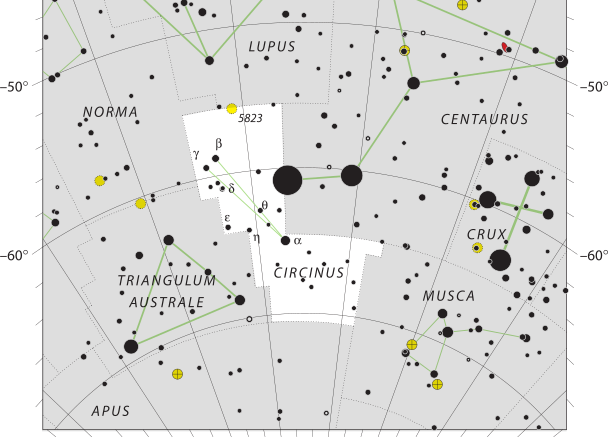Circinus is a small, faint constellation in the southern sky, first defined in 1756 by the French astronomer Nicolas-Louis de Lacaille. Its name is Latin for compass, referring to the drafting tool used for drawing circles. This is similar but different than the symbol for Pyxis in the sky, which represents a mariner’s compass that points north.
Its brightest star is Alpha Circini, with an apparent magnitude of 3.19. Slightly variable, it is the brightest rapidly oscillating Ap star in the night sky. Supernova SN 185 appeared in Circinus in 185 AD and was recorded by Chinese observers. Two novae have been observed more recently, in the 20th century.
The Milky Way runs through the constellation, which means that there are many interest and prominent objects in the constellation such as the open cluster NGC 5823 and the planetary nebula NGC 5315. Circinus hosts a notable spiral galaxy, the Circinus Galaxy, which was discovered in 1977. The Circinus Galaxy has the distinction of being is the closest Seyfert galaxy to the Milky Way.
| Applicable Information | |
| Visibility In Pacific Northwest | Not Visible In Pacific Northwest |
| Best Times To View | Not Visible In Pacific Northwest |
| Right Ascension | 13h 38.4m to 15h 30.2m |
| Declination | −55.43° to −70.62° |
| Area | 93 square degrees |
| Main Stars | 3 |
| Brightest Object | α Cir |
| Meteor showers | Alpha Circinids |
| Messier objects | 0 |
| Neighboring Constellations | Centaurus, Musca, Apus, Triangulum Australe, Norma, Lupus |
History
In 1756, French astronomer Nicolas-Louis de Lacaille introduced the constellation of Circinus with the French name le Compas, representing a pair of dividing compasses, on a chart of the southern sky. On that chart, Lacaille portrayed 4 constellations: Norma, Circinus, and Triangulum Australe. This chart saw the 4 constellations be portrayed as a set square and ruler, a compass, and a surveyor’s level in a set of draughtsman’s instruments. Circinus was given its current name in 1763, when Lacaille published an updated sky map with Latin names for these constellations that he introduced.
Stars
Circinus is a faint constellation, with only one star brighter than fourth magnitude. Alpha Circini, a white main sequence star with an apparent magnitude of 3.19, is 54 light-years away and 4° south of Alpha Centauri.
Three open clusters and a planetary nebula are found within the borders of Circinus, all visible with amateur telescopes of varying sizes. NGC 5823, also called Caldwell 88, is an 800-million-year-old open cluster, is located along the constellation’s northern border. NGC 5823 appears distinct to the observer, sometimes seen as a reversed “S”, as described by John Herschel. That cluster can be easily mistaken with a similar cluster, NGC 5822, nearby in Lupus.
Open cluster NGC 5715 is fainter as its brightest star is only 11th magnitude and comprises only 30 stars. The third open cluster, Pismis 20, contains 12 stars in a diameter of 4.5 arcseconds but exhibits a magnitude similar to NGC 5823 (7.8). At 8270 light-years, it requires an amateur telescope with an aperture over 300 mm to be easily discerned.
The planetary nebula NGC 5315 has a magnitude of 9.8 around a central star of magnitude 14.2, located 5.2 degrees west-southwest of Alpha Circini. It is only visible as a disc at magnifications over 200-fold. Bernes 145 is a dark and reflection nebula first listed in the 1971 Bernes Catalog. The dark nebula component is easily visible in a large amateur telescope, and it measures 12 by 5 arcminutes. The smaller reflection nebula component requires a larger instrument and averted vision to be seen. Bernes 145 is a dark and reflection nebula first listed in the 1971 Bernes Catalog. The dark nebula component is easily visible in a large amateur telescope. The smaller reflection nebula component requires a larger instrument and averted vision to be seen.
Make sure to check out other articles on the site, including a brief introduction to constellations, other constellation articles, and more!

Be the first to comment on "Circinus"